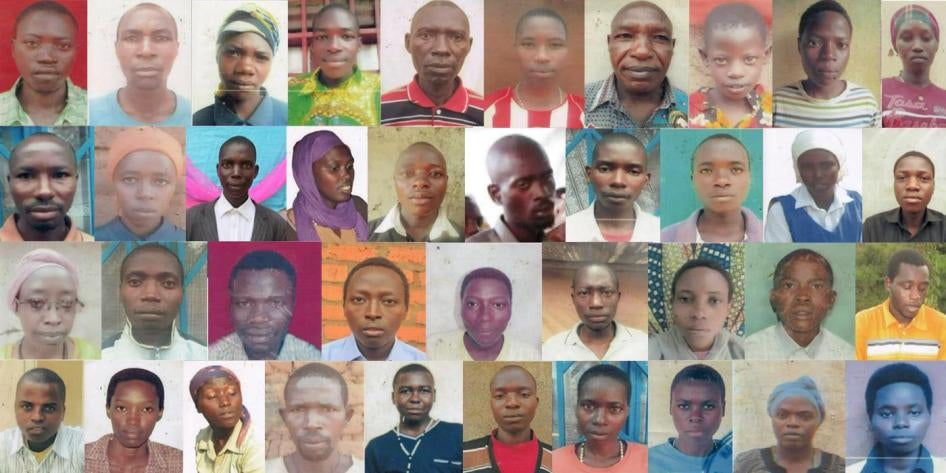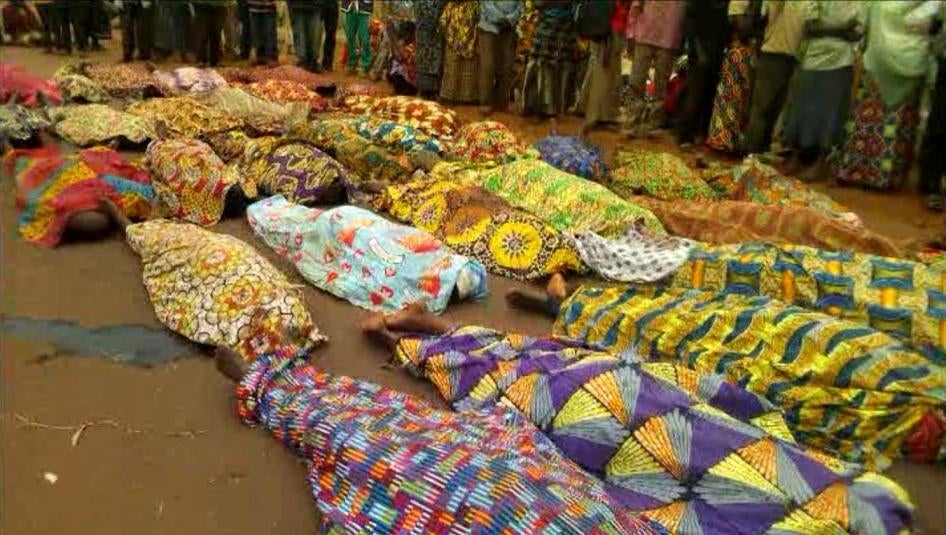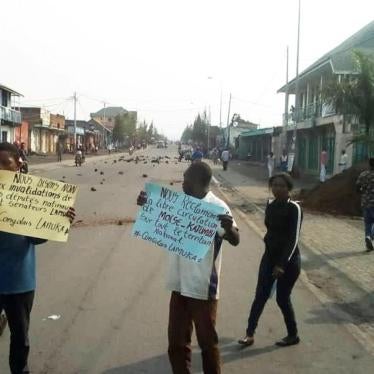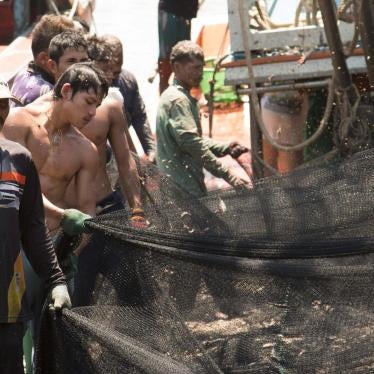(Goma) – The trial of six Congolese security force personnel for the killing of 38 Burundians in eastern Democratic Republic of Congo in 2017 puts the Congolese justice system in the spotlight. Five soldiers and a police officer face charges of “murder and attempted murder” of asylum seekers in the town of Kamanyola before a military court in Bukavu, South Kivu province.
The trial started on June 28, 2019, without the participation of massacre survivors. About 40 Burundian survivors, witnesses, and family members living in Congo have since indicated to a lawyer that they are ready to testify in court, though fewer may do so. The hearings are due to resume on July 29.
“A fair trial for the Kamanyola massacre is critical for justice and for the victims,” said Lewis Mudge, Central Africa director at Human Rights Watch. “Those found responsible for the carnage should be appropriately punished and the victims given meaningful redress.”
On September 15, 2017, Congolese security forces repeatedly fired on some 2,000 Burundian asylum seekers who were protesting in Kamanyola, South Kivu province. Those killed included 15 women, 22 men, and a 12-year-old girl. More than 100 were injured. MONUSCO, the United Nations peacekeeping mission in Congo, had a base a few hundred meters away, but did not intervene until after the shooting stopped.
A 56-year-old Burundian woman told Human Rights Watch: “Nobody came to protect us. They killed us like animals – ruthlessly and heartlessly.”
During the altercation a Burundian asylum seeker shot dead a Congolese army officer. Later that day, local residents stoned to death an asylum seeker.
Soon after the killings, the military prosecutor arrested and filed charges against five military personnel, including the colonel in command of army forces in Kamanyola, and a police officer, who fled after being granted provisional release.
Human Rights Watch investigated the incident and has monitored the judicial proceedings, interviewing more than 50 people, including witnesses, activists, journalists, security force personnel, and Congolese government and UN officials.
The asylum seekers were part of an informal spiritual movement, commonly known as “followers of Zebiya,” who came to Congo after fleeing killings and persecution in Burundi. They chose not to live in official refugee camps and instead moved to Kamanyola, where many were recognized as asylum seekers. Despite years of peaceful coexistence, in September 2017, local Congolese authorities began a campaign of hatred against the asylum seekers in talks replayed on the radio, heightening local tensions. The military’s arrest of four asylum seekers set off the September 15 protests.
Since the Kamanyola killings, most followers of Zebiya fled to Rwanda before returning to Burundi, where they say they live in fear. Some have returned to Congo. A Burundian lawyer, himself a follower of Zebiya, told Human Rights Watch that survivors of the shooting wanted to attend the trial in Bukavu, but fear being identified by Burundian authorities. “It’s simply too dangerous, and we have no guarantees for our safety,” he said in early July. But survivors had expressed the desire to participate in future hearings if their protection could be assured.
Congolese authorities, with the support of MONUSCO, should take all necessary measures to ensure the safety of victims and witnesses who decide to testify, Human Rights Watch said. The government should also investigate the role of local Congolese officials in fanning hate speech prior to the massacre and appropriately prosecute those responsible.
During the incident, Congolese security forces repeatedly fired upon protesters, some of whom threw rocks and engaged in other violence. The UN Basic Principles on the Use of Force and Firearms by Law Enforcement Officials provide that security forces shall as far as possible apply nonviolent means before resorting to the use of force. Whenever the lawful use of force is unavoidable, the authorities should use restraint and act in proportion to the seriousness of the offense. Lethal force may only be used when strictly unavoidable to protect life.
Military courts in Congo have a mixed track record in cases involving military personnel accused of serious crimes. For example, problems emerged in the 2014 trial against Congolese army soldiers implicated in the mass rape in and around the town of Minova in eastern Congo in 2012, including the lack of a solid investigative and prosecutorial strategy, political interference to protect senior commanders and officials, and a failure to respect the rights of the accused to a fair and impartial trial.
“Congolese authorities should take the necessary steps to ensure the Kamanyola trial proceeds credibly and impartially,” Mudge said. “The handling of this case is important not only for the victims, but for ending mass atrocities by Congo’s security forces throughout the country.”
Persecution of “Followers of Zebiya” in Burundi
Starting in the early 2000s, hundreds of Burundians and other Africans made a pilgrimage on the 12th of each month to pray at Businde, a hill in Kayanza province in northern Burundi. Adherents believed that the Virgin Mary conveyed messages to them at Businde through Zebiya Ngendakumana, a prominent woman in the movement, and others.
The spiritual movement known as followers of Zebiya is loose and diverse, without a clear structure or hierarchy. It includes many well-educated men and women, such as teachers, lawyers, civil servants, and students, as well as farmers. Many are women.
A 2012 Burundian government order prohibited followers of Zebiya from worshiping in Businde. On several occasions in 2012 and 2013, police tried to stop them from gathering, resulting in clashes. On March 12, 2013, police fired live ammunition into a large crowd of followers of Zebiya near the prayer site, killing at least nine.
Over several years, the authorities arbitrarily arrested hundreds of followers of Zebiya for taking part in peaceful prayer activities.
In April 2015, Burundian President Pierre Nkurunziza announced he would seek a controversial third term in office, which sparked a political, humanitarian, and human rights crisis in the country. This was followed by an attempted coup in May 2015 and widespread repression against suspected opponents of the government, including the followers of Zebiya.
More than 300,000 Burundians fled their country from April 2015 onwards – and among them, thousands of followers of Zebiya. A member of the movement told Human Rights Watch:
In May 2015 … the ruling party asked everyone to join the cause of the state – or we would be considered as accomplices of the rebels who tried the coup. According to our belief, we can’t do politics. That’s why we couldn’t join their group or any other political group. We couldn’t make a [financial] contribution for anyone either, so we were considered rebels and had to be either killed or put in jail. That’s how I realized that I had no choice but to leave the country so as not to be killed. They had a slogan that said that all rebels would be “cleansed” [a euphemism for “killed”].
Another follower of Zebiya said he left Burundi after the Imbonerakure, the abusive ruling party youth league, started looking for him: “I knew that at any moment I could be killed.… I went to Congo to save my life.”
Refuge and Rising Tensions in Kamanyola
Many followers of Zebiya who sought protection in Congo settled in towns of South Kivu province, including Uvira, Bukavu, and Kamanyola. They chose towns over refugee camps, in part because of security reasons as camps in other countries neighboring Burundi were reportedly infiltrated by the Burundian intelligence services. “We thought that, in a camp, you can easily be spotted and killed,” said a Congolese follower of Zebiya who helped asylum seekers settle. “Kamanyola was [a] strategic [location] for them, because it’s easy to cross the border to go to Rwanda in case there’s a problem.”
Thousands of followers of Zebiya settled in Kamanyola, and many obtained papers from Congo’s refugee agency recognizing them temporarily as asylum seekers. Some stayed with host families, including with Congolese movement members, while others rented accommodation or built shelters. Many worked as daily laborers in the fields.
“When we arrived in Kamanyola, we were welcomed by the local population, with whom we lived without any difficulty,” one Burundian said. They first prayed in church with the Catholic residents, but later began to pray in groups in their homes “so as not to offend” the others with their religious practices, he said.
The peaceful cohabitation between the residents in Kamanyola and the Burundian followers of Zebiya ceased abruptly in September 2017. A delegation from Burundi had reportedly visited Congo a few weeks earlier to discuss, among other things, the return of refugees. One resident who attended a security meeting in Kamanyola that September said:
I heard with my own ears the administrator of Walungu territory, Mr. [Dominique] Bofondo, say: “I received a delegation from Burundi who came to inform me that Burundian refugees no longer have any reason to stay on Congolese soil under the pretext that they are fleeing the war. Burundi is already calm, and everyone must return to the country.” That’s why we must do everything we can to bring them back to their country.
Burundian officials conveyed similar messages to refugees in Uganda and Tanzania, pressing them to return home.
A Congolese follower of Zebiya said that Bofondo warned him on September 6 that he would face “serious problems” if he continued to act on behalf of the Burundian asylum seekers. “We want these people to go back to their country because there is no longer a problem there,” he said Bofondo told him.
MONUSCO said it contacted local authorities on September 6 “with the aim of avoiding clashes between the asylum seekers and the local population.”
On September 7, Bofondo addressed the Burundian followers of Zebiya in Kamanyola. He told them that they did not have the right to buy houses or land. He also prohibited them from praying in their houses and threatened to burn the houses if they persisted, several witnesses said. In a separate meeting that day, Bofondo conveyed a similar message to Congolese residents, in the presence of Bertin Zagabe, the local administrator in Kamanyola, according to people at the meeting.
Town residents said that local radio stations broadcast Bofondo’s speech. After the September 15 massacre, however, the recordings could not be found at any of the radio stations. “I know there was pressure to make that recording disappear,” a local radio journalist said. Another journalist said that the intelligence services “infiltrated all local stations to erase all the reports that were made” in connection with the massacre.
Following Bofondo’s September 7 visit, Kamanyola residents turned overtly hostile toward the Burundians, making statements such as, “We will burn you!” A 67-year-old Burundian asylum seeker said: “We began to hear young children telling us, ‘Burundians, go back home! These fields, you won’t harvest them!’ I understood that something was wrong, because a child cannot say these things if they have not heard them somewhere.” A Burundian woman said that the day the administrator came, he “changed everything; the peaceful climate – that was over.” Another Burundian said that after the speeches, a Congolese neighbor told him: “We are authorized to do with you what we want!”
Human Rights Watch contacted Bofondo on several occasions by phone, but he was not available for comment.
The Kamanyola Massacre
Human Rights Watch’s account is based largely on interviews with witnesses in Kamanyola in November 2017 and since then by phone and in person in Goma.
On the night of September 12 to 13, 2017, soldiers in Kamanyola arrested four Burundian men they accused of patrolling without authorization and storing crude weapons. On September 15, the men’s wives came to the office of the National Intelligence Agency (Agence nationale de renseignements, ANR) – where they were being held – but were denied access. They then saw officials drive the men away in the direction of Burundi and alerted other people. As most asylum seekers were praying together in houses at that time, the news spread quickly.
The followers of Zebiya then gathered in front of the intelligence agency office and were asked to choose five representatives. “The choice was not made quickly,” one Burundian man said. “There were concerns that those chosen would also be arrested.” A member of the security forces, who witnessed the scene, said that the local police commissioner, Mwambonga Kalimbe Arija, then left on a motorbike. The talks with the followers of Zebiya continued. The group grew bigger, reaching about 2,000 movement members. Congolese residents also joined to see what was happening. Witnesses said that Zagabe, the Kamanyola administrator at the time, was there as well.
Arija soon returned with another police officer. “[Arija] got off the bike and started hitting the refugees with a stick,” the security force witness said. “I think he’s the one who caused everything that followed!” One woman said: “The policeman with his police baton started hitting us, saying, ‘Go back! Go back!’” Asylum seekers then started throwing stones at the security forces.
The security force witness said an intelligence agency official was hit in the head by a stone. “A policeman then fired warning shots to frighten the refugees, who did not move an inch,” he said. “Stones continued to be thrown. The policeman lowered his weapon and shot at the crowd. A young woman fell immediately, hit in the head [with a bullet].” Fellow followers of Zebiya identified her as Clairia Manirakiza, a 26-year-old Burundian.
After that, a Congolese army officer, Captain Mbuza, arrived on a motorcycle with an escort, from the direction of Rwanda. “More police officers also came from that side,” the security force witness said. “They then fired warning shots to disperse the angry crowd.”
The witness said Mbuza was killed shortly afterwards by a young Burundian man:
People were moving toward [the security forces] and they backed away. Then Captain Mbuza tripped from behind on a rock and fell. A young man rushed at him and took his gun away, shot him directly and then shot at a policeman – I think he got hit in the leg. It was at this point that the police again fired at the refugees at close range, two other people were shot, and the shooting continued…. The refugees had backed away to flee, but they then found themselves in front of soldiers who had come en masse to help their colleagues. They shot people indiscriminately and then brought in a machine gun with which they fired without restraint.
A Congolese activist also said that an asylum seeker had killed Mbuza. Human Rights Watch was not able to verify the full circumstances of Mbuza’s death or to confirm the injury to the policeman.
Many survivors described the shooting. One said:
The bullets continued, continued, and people fell, wounded or dead. All this was happening as we were attempting to return home, but on the way, we found ourselves in front of a wall of soldiers who were shooting at us. They had a machine gun in the middle of the road and there were other soldiers on both sides, so we couldn’t escape. It seemed that the [local] population cheered on the soldiers who were killing us. We threw stones, and the population threw stones at us.
Another survivor described the machine gun: “It had a thick belt with plenty of bullets.... Its long belt extended along the main road.”
“One refugee [next to me] held his bible in his hand. A bullet went through his bible and touched his hand … blood came out,” an asylum seeker said. “A second bullet hit my arm and another bullet struck my left thigh. I fell instantly to the ground. I had the impression that my leg was cut off.” Another survivor said that “most refugees held their hands up and sang psalms asking God to save us.”
Some survivors threw stones to protect the bodies and the injured so that the soldiers would not take them away. They attempted to carry the dead and injured towards the MONUSCO base. One survivor said that most of those killed were hit by bullets “in the head or in the back, because they were hit while they tried to recover the bodies of the dead and the injured.” Accounts of the duration of the shooting varied from a few minutes to one hour.
Human Rights Watch in November 2017 interviewed Lt. Col. Mavita Sasu Debaba, the army commander in Kamanyola at the time of the killings. Debaba had been arrested and was in prison in Bukavu. He claimed that he only arrived toward the end of the shooting. He said he then ordered the soldiers – there were 23 including himself – to stop shooting and told the young residents to stop throwing stones. He said the soldiers then returned to their base.
That evening, young men stopped and beat two Burundian asylum seekers, as they attempted to reach the MONUSCO base, killing Donatien Nayizeye. The surviving asylum seeker said: “I could see from afar that [Nayizeye] was being smashed [to death] with stones.”
Trials
The Congolese military prosecutor arrested five military personnel on charges of murder and attempted murder: Lt. Col. Debaba, Second Lt. Jean Kabange Kalumba, Sgt. Maj. Eli Numbi, Sgt. Maisha Ngangu, and Deputy Adj. Munguiko Barigira. Debaba is also charged with “inciting military personnel to commit unlawful acts.” Arija, the former Kamanyola police chief, is also listed as a defendant. He was granted provisional release, but the court considers him to have fled because they could not contact him and he attended no hearings.
The judicial investigations identified 12 other suspects – including soldiers who were sent to the front in Fizi territory soon after the massacre. The prosecutor’s office is not known to have issued arrest warrants for their arrest.
The military prosecutor’s referral decision lists only the names of 22 dead and 91 injured. It was not clear why the list was not complete.
Bofondo and Zagabe are considered informants in the trial. Zagabe is now the territorial administrator for Mwenga, also in South Kivu province. It is not clear if Bofondo still holds a position in the administration.
MONUSCO provided technical, logistical, and financial support to the judicial investigation and trial preparations.
The trial began on June 28, 2019, with a second hearing on July 1. Because the asylum seekers who witnessed the shootings were not represented at the initial hearings, the court gave them another chance to participate. In July, nongovernmental organizations and lawyers helped raise awareness about the trial among the survivors. One lawyer told Human Rights Watch that about 40 Burundian asylum seekers were ready to testify in court.
The four Burundian men who were arrested in Kamanyola shortly before the massacre were all convicted in April 2019 of “criminal association” and sentenced to 10 years in prison, according to a prison official. They remain incarcerated at the Uvira prison, awaiting an appeal trial.
UN Peacekeepers’ Failure to Respond
MONUSCO, the UN peacekeeping mission, had a base a few hundred meters from the massacre site in Kamanyola, yet failed to protect civilians. UN Security Council resolution 2348 (2017) stated that one of MONUSCO’s main priorities is to “[e]nsure effective and dynamic protection of civilians under threat of physical violence.”
On January 16, 2018, UN Under-Secretary-General for Peace Operations, Jean-Pierre Lacroix, created a special investigation into MONUSCO’s response to the Kamanyola massacre. The findings have not been made public.
In an October 16, 2018 letter, MONUSCO responded to questions from Human Rights Watch about the incident. The mission wrote that their base in Kamanyola:
was aware sometime around 16:00 [on September 15, 2017] that all was not well in Kamanyola and did not respond until after all shooting had ended. Based on subsequent reviews, the Mission believes the COB [company operating base] responded at best 2 hours after being made aware of the incident – and potentially later.
MONUSCO wrote that the commander of the base was not present at that time, and that the acting commander of the base “engaged in extensive consultations with his hierarchy and individuals at the base prior to dispatching forces to investigate the incident, rather than taking the responsibility to send a patrol himself.” Furthermore, there was “some evidence that certain members of the COB may have considered that the protection of civilians mandate was less applicable to cases where Congolese national authorities were taking action. In addition, certain members of the Force were clearly unsure about what the role of Force members should play in responding to civilian demonstrations.”
MONUSCO said its forces are “expected to respond to incidents within 15 minutes of them taking place,” and acknowledged that “this guideline was clearly not met.”
MONUSCO said that UN forces helped bring asylum seekers to their base later that day:
Two MONUSCO patrols were dispatched in response to the sound of shots being fired…. They were told by individuals they met that the FARDC [Congolese army] were still shooting in nearby neighborhoods and continued on to Rubumba/Mulira (2km from the base). The patrol did not observe any FARDC members. They extracted 18 asylum seekers from the Rubumba area and brought them to the COB.
MONUSCO assisted and evacuated the wounded, and also established a protective perimeter outside its gates for between 500 to 1,000 asylum seekers. MONUSCO also assisted with the burial of bodies, and “continued to provide security to groups of asylum seekers until they were escorted [by MONUSCO] to Rwanda” in March 2018, after the Burundians “perceived that serious threats had been made against them by other residents.”
MONUSCO informed Human Rights Watch that it was unable to comment on whether disciplinary action was taken against any of the UN peacekeepers involved.











